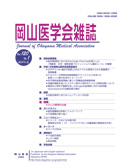

Journal of Okayama Medical Association
Published by Okayama Medical Association<Availability>
Full-text articles are available 3 years after publication.
Permalink : http://escholarship.lib.okayama-u.ac.jp/16283
Studies on the characteristics of human lung mast cells Ⅱ. Reactivity of human lung mast cells
Maeda, Masanori
Published Date
1986-06-30
Abstract
Many pathophysiological and therapeutic investigations on allergic pulmonary diseases have been reported using chopped lung tissue or rat peritoneal mast cells. However, there are some problems with these experimental systems. The major problem is the difference in the responsiveness of mast cells to stimuli among species or organs. In this study, reactivity of isolated human lung mast cells to immunological and non-immunological stimuli was examined. Isolated human lung mast cells showed a maximum histamine release of 47.9±11.2% at 10μg/ml of calcium ionophore A23187. The reaction was dependent on the concentration of calcium ionophore A23187 and extracellular Ca(2+). Compound 48/80 failed to induce histamine release from the mast cells below the concentration of 1000 μg/ml. The optimal condition for the passive sensitization of the mast cells was incubation at a final concentration of 1000U/ml in IgE serum at 37℃ for 2 hours. This treatment significantly enhanced immunological response. Maximum histamine release of 36.0±5.7% from the mast cells after passive sensitization was shown by anti-IgE. The reaction was dependent on the concentration of anti-IgE and extracelullar Ca(2+). The mast cells from a patient with buckwheat allergy released histamine by treatment with anti-IgE, specific antigen, anti-IgG and anti-IgG(4) in a concentration-related manner. Isoproterenol and nicardipine inhibited histamine release induced by anti-IgE in a dose-dependent manner, indicating maximum inhibition rates of 37.8±7.0% at 10(-6)M and 41.2±11.9% at 5 μg/ml, respectively. Scanning electron microscopic examination showed the absence of microvilli and degranulation of the intracellular contents after immunological stimulation. Acetylcholine induced significant histamine release from the mast cells at a concentration of 10(-4)M. These results suggest that human lung mast cells have specific reactivity to some stimuli. Further studies of human lung mast cells are required to clarify the pathogenesis of allergic pulmonary diseases.
Keywords
human lung mast cell
IgE-mediated reaction
histamine release
passive sensitization
heterogeneity
ISSN
0030-1558
NCID
AN00032489
